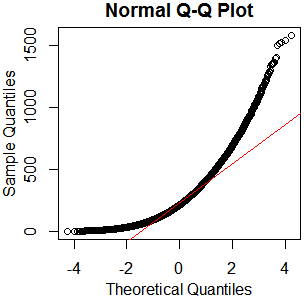I'm examining a part of my dataset containing 46840 double values ranging from 1 to 1690 grouped in two groups. In order to analyze the differences between these groups I started by examining the distribution of the values in order to pick the right test.
Following a guide on testing for normality, I did a qqplot, histogram & boxplot.



This doesn't seem to be a normal distribution. Since the guide states somewhat correctly that a purely graphical examination isn't sufficient I also want to test the distribution for normality.
Considering the size of the dataset and the limitation of the shapiro-wilks test in R , how should the given distribution be tested for normality and considering the size of the dataset, is this even reliable? (See accepted answer to this question)
Edit:
The limitation of the Shapiro-Wilk test I'm referring to is that the dataset to be tested is limited to 5000 points. To cite another good answer concerning this topic:
An additional issue with the Shapiro-Wilk's test is that when you feed it more data, the chances of the null hypothesis being rejected becomes larger. So what happens is that for large amounts of data even very small deviations from normality can be detected, leading to rejection of the null hypothesis event hough for practical purposes the data is more than normal enough.
[...] Luckily shapiro.test protects the user from the above described effect by limiting the data size to 5000.
As to why I am testing for normal distribution in the first place:
Some hypothesis tests assume normal distribution of the data. I want to know whether or not I can use these tests.



